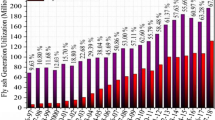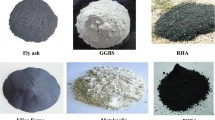The object of investigation is the ceramic material taken from the fortress wall in the city of Girona. The chemical composition of the researched material showed a heightened content of carbon (13.1%) in it, attesting the introduction of fuel into the green body. The heightened content of fuel in the green body promotes porosity formation and uniform sintering inside the ceramic sample. The integral and differential programs of the research samples, which were obtained by means of mercury porosimetry, showed that the total volume of the micropores ranging in size from 10 – 4 to 10 – 8 m is equal to 0.155 cm3/g. The differential distribution of micropores as a function of their size is: 10 – 4 – 10– 5 — 27% (reserve – non-hazardous); 10 – 5 – 10– 6m— 19% (hazardous); 10 – 6 – 10– 7 m — 29%; 10 – 7 – 10– 8 m — 25% (non-hazardous).




Similar content being viewed by others
References
V. Z. Abdrakhimov, “Technical properties and porosity structure of clinker materials based on non-ferrous metallurgy waste of Eastern Kazakhstan,” Khim. Tekhnol., No. 11, 499 – 506 (2019).
N. D. Yatsenko, E. A. Yatsenko, and S. G. Zakarlyuka, “Phase composition and properties of building ceramics as a function of the content of calcium carbonates and iron oxides,” Steklo Keram., No. 9, 7 – 10 (2016); N. D. Yatsenko, E. A. Yatsenko, and S. G. Zakarlyuka, “Phase composition and properties of building ceramics as a function of the content of calcium carbonates and iron oxides,” Glass Ceram., 73(9 – 10), 319 – 322 (2016).
V. Z. Abdrakhimov and E. S. Abdrakhimova, “Study of the distribution of iron oxides in intershale clay and oil sludge porous filler with Mossbauer spectroscopy,” Theor. Found. Chem. Eng., 53(4), 703 – 707 (2019).
A. A. Sergeenkova and I. A. Akulova, “Phase transformations in ash-ceramic material,” in: A. A. Gorokhov (ed.), Collection of Scientific Works of the 8th All-Russia Sci. Techn. Conf. with International Participation [in Russian], South-West State University, Kursk (2018), pp. 205 – 214.
V. F. Pavlov, Physico-Chemical Principles of the Firing of Building Ceramics [in Russian], Stroiizdat, Moscow (1977).
E. S. Abdrakhimova and V. Z. Abdrakhimov, “Chemical, phase compositions and porosity structure of the plinth brick of the White Tower (Greece) of age greater than 450 yr,” Steklo Keram., No. 4, 40 – 43 (2019); E. S. Abdrakhimova and V. Z. Abdrakhimov, “Chemical, phase compositions and porosity structure of the plinth brick of the White Tower (Greece) of age greater than 450 yr,” Glass Ceram., 76(3 – 4), 152 – 154 (2019).
M. K. Galperina and A. V. Erokhina, “Kinetics of changes in the porosity structure during firing of clays with different mineralogical composition,” Tr. Inst. NIIstroikeramiki, No. 45, 3 – 18 (1981).
Author information
Authors and Affiliations
Corresponding author
Additional information
Translated from Steklo i Keramika, No. 7, pp. 42 – 46, July, 2020.
Rights and permissions
About this article
Cite this article
Abdrakhimova, E.S., Abdrakhimov, V.Z. Investigation of the Porosity Structure in the Ceramic Wall Material of the Fortress in Girona (Spain). Glass Ceram 77, 280–283 (2020). https://doi.org/10.1007/s10717-020-00288-3
Published:
Issue Date:
DOI: https://doi.org/10.1007/s10717-020-00288-3




